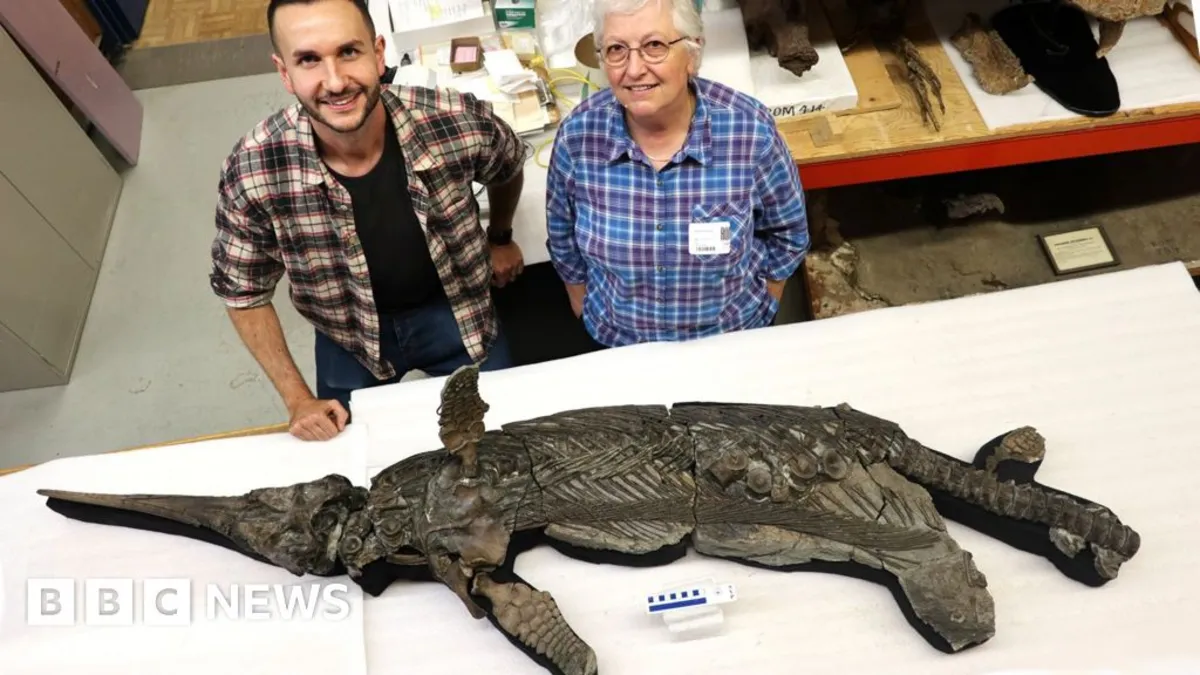
A near-complete skeleton unearthed along Dorset's Jurassic Coast has been officially identified as a new species of ichthyosaur, a fascinating type of prehistoric marine reptile that once dominated the oceans. This dolphin-sized ichthyosaur has been named Xiphodracon goldencapensis, or the "sword dragon of Dorset," marking it as the only known specimen of its kind.
The remarkable ichthyosaur was first discovered in 2001 by a prolific fossil hunter named Chris Moore at Golden Cap in Dorset. After its discovery, the fossil was acquired by the Royal Ontario Museum in Canada, where it took more than 15 years to undergo thorough analysis. Recently, a research paper was published that identified this skeleton as a distinct new species of ichthyosaur.
Dr. Dean Lomax, an ichthyosaur expert and co-author of the research paper, shared his thoughts on the naming process. "I thought long and hard about the name," he explained. The term Xiphodracon translates to "sword-like dragon," referencing its long, sword-like snout and the historical description of ichthyosaurs as "sea dragons" for nearly two centuries.
This particular ichthyosaur is believed to have roamed the oceans approximately 185 million years ago, a period during which very few ichthyosaur fossils have been discovered. Dr. Lomax emphasized the importance of Xiphodracon, stating, "During this time, ichthyosaurs are incredibly rare, and Xiphodracon is the most complete individual ever found from that era, helping to fill a gap in ichthyosaur evolution." This discovery is regarded as a significant missing piece in understanding the evolution of these remarkable marine reptiles.
Measuring around 3 meters in length, the sword dragon exhibits several unique features that have not been observed in other ichthyosaur species. Among the most intriguing details is a prong-like bone located near its nostril. The skull of Xiphodracon contains a massive eye socket and an elongated, sword-like snout, which it likely used to capture fish and squid.
Insights into the lifestyle and demise of this ichthyosaur have also been revealed. According to Dr. Erin Maxwell, a co-author of the study from the State Museum of Natural History Stuttgart, the limb bones and teeth of Xiphodracon show signs of serious injury or disease. "The skull appears to have been bitten by a large predator, likely another much larger species of ichthyosaur, indicating the cause of death for this individual," she explained. Life in the Mesozoic oceans was undoubtedly perilous.
The discovery of the "sword dragon" adds to the rich history of ichthyosaur fossils found along Dorset's Jurassic Coast, a region first explored by pioneering paleontologist Mary Anning in the early 1800s. Chris Moore, who discovered this remarkable specimen, noted that he has unearthed approximately 15 ichthyosaurs, with several, including the sword dragon, being classified as new species.
Mr. Moore expressed his excitement for the new discovery, stating, "I don't wish to blow my own ichthyosaur trumpet, but I have found a few of them." He is currently planning to celebrate this monumental find, although he is still undecided on how to do so—whether with a bottle of champagne or a simple mug of tea remains to be seen.